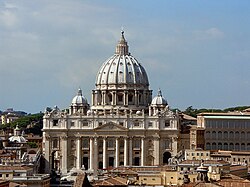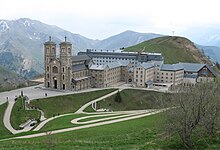Christian pilgrimage: Difference between revisions
Tgl master (talk | contribs) mNo edit summary |
|||
| Line 230: | Line 230: | ||
==External links== |
==External links== |
||
* {{CathEncy|wstitle=On Pilgrimages}} |
* {{CathEncy|wstitle=On Pilgrimages}} |
||
* [http://digitalcommons.linfield.edu/soanstud_theses/3/ Tracing Taizé: Rebuilding Global Solidarity through Religious Pilgrimage] Senior Thesis exploring religious pilgrimage, specifically within the Christian tradition |
|||
{{Use dmy dates|date=June 2011}} |
{{Use dmy dates|date=June 2011}} |
||
{{DEFAULTSORT:Christian Pilgrimage}} |
{{DEFAULTSORT:Christian Pilgrimage}} |
||
Revision as of 22:08, 28 June 2011

Christian pilgrimage was first made to sites connected with the ministry of Jesus. Surviving descriptions of Christian pilgrimages to the Holy Land and Jerusalem date from the 4th century, when pilgrimage was encouraged by church fathers like Saint Jerome and established by Helena, the mother of Constantine the Great. Pilgrimages also began to be made to Rome and other sites associated with the Apostles, Saints and Christian martyrs, as well as to places where there have been apparitions of the Virgin Mary.
In Christianity however, according to Paul, pilgrimage is not a necessity according to an interpretation[who?] of this passage of the Bible: 1st Corinthians 9: 19 "Or do you not know that your body is the temple of the Holy Spirit who is in you, whom you have from God, and you are not your own? 20 For you were bought at a price; therefore glorify God in your body and in your spirit, which are God’s."
Major Christian pilgrimage sites
Bosnia-Herzegovina
- Međugorje. Apparitions of the Virgin Mary from 1981 up to the present time
Brazil
- Basilica of the Shrine of Our Lady of Aparecida - one of the largest churches in the world and receives about 8 million visitors per year.
France

- The several churches and basilicas in Lourdes - associated with Marian apparitions receive over 5 million pilgrims a year, making Lourdes the second most visited Christian pilgrimage site in Europe after Rome.
- Paris - the cathedral of Notre Dame de Paris, and Basilica of Sacré-Coeur in Montmartre
- Basilica of St. Thérèse (Lisieux) - in Normandie. The second pilgrimage site in France after Lourdes with over 2 million visitors per year.
Germany
Hungary
Israel

The Holy Land, location of many events in the Old Testament and New Testament:
- Bethany, site of the resurrection of Lazarus
- Bethlehem, birthplace of Jesus and King David.
- Jerusalem, site of the Passion (The Via Dolorosa) and Resurrection of Jesus.
- Mount Tabor, site of the Transfiguration
- Nazareth, hometown of Jesus
- Sea of Galilee, site of Jesus' early ministry.
- The House of Peter in Capernaum.
- The Jesus trail.
Italy

- Vatican City - Location of Saint Peter's Basilica, relics of various saints, relics of the Passion, important churches and headquarters of the Roman Catholic Church.
- Rome - on roads such as the Via Francigena. Site of the deaths of Saint Peter, Saint Paul and other early martyrs.
- Padre Pio Pilgrimage Church - the Padre Pio shrine located in San Giovanni Rotondo of southern Italy; also Pietrelcina as the birthplace of Padre Pio
- Basilica of St. Francis - in Assisi; also church of Saint Clare
- Loreto - in the Marche; home of the Basilica della Santa Casa
Mexico
- Basilica of Our Lady of Guadalupe - one of the largest churches in the world and receives about 20 million pilgrims per year. It can accommodate 40,000 people for a mass.
Poland


- Jasna Góra Monastery in Częstochowa, where the Black Madonna of Częstochowa is housed permanently. It receives about 4.5 million pilgrims a year.
- The Sanctuary of Our Lady of Licheń in Licheń Stary, the home of the image of Our Lady of Licheń, known as the Sorrowful Queen of Poland. This expansive complex receives well over a million pilgrims a year.
Portugal
- Fátima - Our Lady of Fatima is the title given to the Blessed Virgin Mary. She appeared to three shepherd children at Fátima on the 13th day of six consecutive months in 1917. Fatima receives about 4-5 million pilgrims a year.
Spain
- Santiago de Compostela - in Galicia on the Way of St James (Galician: O Camiño de Santiago). This famous medieval pilgrimage to the shrine of Saint James is still popular today.
Turkey
- Constantinople (today Istanbul). Former capital of the Byzantine Empire and the see of one of the five ancient Patriarchates and first among equals among the Patriarchs of the Eastern Orthodox Church. Hagia Sophia, former cathedral and burial place of many Ecumenical Patriarchs.
- House of the Virgin Mary located in Ephesus. The former home of the Virgin Mary until her Assumption/Dormition currently a shrine. It was blessed and declared a place of pilgrimage by Pope John Paul II.
- Antioch. Early Center of Christianity and official seat of the Antiochian Orthodox Church. Home to many old Christian churches.
Other pilgrimage sites
Armenia




- Etchmiadzin (Mother See of Holy Etchmiadzin). Etchmiadzin is the spiritual and administrative centre of the Armenian Apostolic Church
Austria
- Mariazell. Marian Shrine to Austria and Hungary
Canada
- Basilica of Sainte-Anne-de-Beaupré, Quebec, associated with miraculous healings.
- Cap-de-la-Madeleine, Quebec, in honour of Our Lady of the Cape.
Czech
Egypt
- Saint Catherine's Monastery, Mount Sinai, traditional site of the Burning Bush and the reception of the Ten Commandments has been commemorated since the time of Constantine the Great
- Monastery of Saint Anthony, a Coptic Orthodox monastery/cathedral located in the Eastern Desert. It is a very important model for many monastics.
France
- Sanctuary of Our Lady of Lourdes. A very important marian apparition shrine to Catholics.
- Cathedral of Chartres.
- Conques.
- Issoudun.[2]
- La Salette, Our Lady of La Salette
- Saint Catherine Labouré of Paris
- Pellevoisin. Apparition of the Virgin Mary.
- Taizé Community, modern monastery that actively encourages pilgrimages to it.
Germany
- Basilica of the Vierzehnheiligen.
- St. Maria in der Kupfergasse, Cologne
- Kevelaer
- Wittenberg. Church of Martin Luther and center of the Protestant Reformation.
Greece
- Mount Athos. Orthodox monastic centre.
- Tinos.
- Patmos. island of Revelation.
India
- Goa. St. Francis Xavier
- St. Thomas Mount. Place where St. Thomas was martyred.
- Vailankanni. 16th-century Marian apparition site.
Ireland
- Croagh Patrick. Saint Patrick.
- Knock
- St. Patrick's Purgatory, Donegal.
Italy
- Padua, St Anthony, relics
- Sacri Monti. The Sacred Mountains of Piedmont and Lombardy.
- Turin, the location for the Shroud of Turin.
The place of The Holy Excretion
- St. Peter's Basilica, the burial place
Jordan





- Mount Nebo, traditional site of the death of Moses.
- Mukawir, the Herodias fortress where John the Baptist was imprisoned and beheaded.
- Um Qais, the city is mentioned in the New Testament as the site where Jesus cast out demons and sent them into pigs, which then ran into the sea.
- Jordan River, this site has been recognized as the real (and only true) site where Jesus was baptized by all the major traditional Christian Churches.
Lithuania
- Hill of Crosses, near Šiauliai,
- Žemaičių Kalvarija, Samogitia,
- Our Lady of the Gate of Dawn, Vilnius,
- Šiluva.
Mexico
- Basilica of Our Lady of Guadalupe. Important shrine near Mexico City, on Tepeyac Hill where the Virgin Mary appeared to St. Juan.
- Zapopan
- San Juan de los Lagos
Netherlands
Norway
Philippines
- National Shrine of Our Mother of Perpetual Help. One of the most venerated Marian images in Asia.
- Our Lady of Manaoag is one of the Philippines' most widely visited Roman Catholic Pilgrimage sites and the patroness of the sick, the helpless and the needy.
- Quiapo Church. Home to the much venerated Black Nazarene, a much venerated statue of Jesus Christ which many people believe has miraculous attributes
Poland
- Góra Świętej Anny
- Kalwaria Zebrzydowska
- Sanctuary of Our Lady of Ludźmierz in Ludźmierz
- Sanctuary of St. Hedwig in Trzebnica
- Supraśl Lavra
- Święta Lipka
- Wambierzyce
Romania
- Miercurea Ciuc, Transylvania. Whit Sunday gathering of (mostly ethnic Hungarian) Catholics.
Slovakia
Spain
- Ávila, St Theresa of Avila, relics
- Basilica of Our Lady of the Pillar in Zaragoza. It's reputed to be the first church dedicated to Mary in history.
- Caravaca de la Cruz, Region of Murcia
- Montserrat, Catalonia. The Virgin of Montserrat is housed permanently in the monastery of Santa Maria de Montserrat.
- Guadalupe.
- Santo Toribio de Liébana, Cantabria.
Switzerland
Syria
Turkey
- House of the Virgin Mary. Pope John-Paul II declared the Shrine of Virgin Mary as a pilgrimage place for Christians.[3]
- Constantinople. Present city, Istanbul; The world-wide capital of the Greek Orthodox Church and home to many of the oldest churches in the world. It is home to the Church of St. George, Istanbul seat of the Patriarch of Constantinople leader of the Greek Orthodox Church.

UK
- Canterbury Cathedral, England. Associated with Saint Thomas Becket
- Glastonbury, England. Saint Joseph of Arimathea
- St Andrews, Scotland. It is said that Saint Andrew was given, by God, directions to the location of St Andrews
- Walsingham, England. Virgin Mary apparition site
- Holywell, Wales. St Winefride's Well is alleged to be the oldest continuously operating pilgrimage site in Great Britain
- St David's, Wales. Pilgrimage site since canonisation of the saint in the twelfth century
- St Albans Cathedral, England. Associated with the country's first martyr, Saint Alban
- Lindisfarne, England. Saint Cuthbert's remains were removed in 875 and finally transferred to Durham Cathedral in 1104
- Bromholm Priory, England. Claimed to possess a piece of the True Cross
- Struell Wells, Northern Ireland. Traditionally associated with Saint Patrick
USA
- Carey, Ohio to the Basilica and National Shrine of Our Lady of Consolation. Catholic pilgrims from the Middle East journey here to mark the Feast of the Assumption.[4]
- The National Shrine of Our Lady of Czestochowa in Doylestown, Pennsylvania.
- The Black Madonna Shrine in Eureka, Missouri.
- El Santuario de Chimayo, New Mexico
Record-breaking Pilgrimages
World Youth Day is a major Catholic Pilgrimage, specifically for people aged 16–35. It is held internationally every 2–3 years. In 2005, it was held in Cologne, Germany. In 1995, the largest gathering of all time was to World Youth Day in Manila, Philippines, where four million people from all over the world attended.[5]
In the media both manifestations are usually referred to as 'pilgrimages', but actually in the strict meaning of the word they are not pilgrimages as they are (each time) once-only religious gatherings for a specific purpose (funeral, religious renewal for the youth) and not focused at a shrine based cultus-object for veneration. However, since the funeral, the proper grave of John Paul II is actually indeed becoming a new site of pilgrimage in Rome.[citation needed]
See also
References
- ^ Mariapocsi-zarandokhaz.ur
- ^ Notre-Dame du Sacré-Coeur
- ^ House of the Virgin Mary listing at www.Ephesus.US
- ^ Basilica and National Shrine of Our Lady of Consolation official website
- ^ "World Youth Day". Retrieved 10 March 2011.
{{cite web}}:|first=missing|last=(help) - ^ PPOT.net
External links
- Herbermann, Charles, ed. (1913). . Catholic Encyclopedia. New York: Robert Appleton Company.
- Tracing Taizé: Rebuilding Global Solidarity through Religious Pilgrimage Senior Thesis exploring religious pilgrimage, specifically within the Christian tradition
